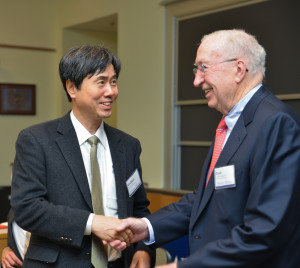
The Mack Institute hosted its annual Fall Conference on November 22, 2013 with the Program on Vehicle and Mobility Innovation (PVMI) on the topic of “When Disruptive Technologies Meet Integrated Systems: Who Captures the Value?” This guest post by three PVMI researchers summarizes key takeaways from the conference, including the growing relevance of cross-industry integration and the importance of the supply chain to future research in the automobile industry.
If we look at the road that vehicle and mobility innovation has taken, we can see that the lines which separate this industry from others are starting to blur.
This year’s Fall Conference has shown us that forays into IT- and community-based business models have led to the expansion of this industry’s ecosystem, and gives us an idea of where further integration and innovation could take us.
Considering the current state of the industry, it’s safe to say that automotive firms will survive or fail based on the combined efforts of all the members of their business ecosystem. In various countries like India, China, and the US, their present successes can all be attributed to the collective health of all their ecosystem members.
Efforts made by companies like Nissan towards bringing the autonomous car into fruition have advanced technologies which used to be seen only in science-fiction movies. Movement towards inclusion and collaboration—as seen through the example of Relay Rides—has shown us that a community-based model can also be effective in the automotive industry. As these efforts bring about a rapid change in the automotive technology, we should start to consider further integration with other industries, calling for an increase in creativity.
R&D should become more customer-centric and respond to what the market actually requires. This would help prevent the phenomenon of R&D paradox, wherein investments in R&D do not translate into market creation. Still, the importance of creativity in the form of R&D investments play a major part, not only in obtaining and maintaining market share, but also in attaining sustainability.
PVMI should serve as a platform from which innovation and cross-industry collaboration can launch. We should see more cross-industry integration in the future, following mergers like those of Google and Motorola, which weave the strengths and technologies of both ecosystems together to bring about a larger, healthier business ecosystem. This would enable all members to pursue and achieve monumental innovation which bring once unimaginable products and technologies into reality.
Future research should focus on the impact on the supply chain in line with the evolution of automobile industry paradigms, brought about by the advancement in technologies such as the shift from traditional vehicles to environmentally friendly vehicles and smart cars. In this light, inviting representatives from the auto parts suppliers and other related industries to participate in future conferences could provide valuable insight into this anticipated change.
Further growth on the automotive industry would require the collaboration of all its ecosystem members, and research on this area proves to be encouraging. The integration of hardware, software, contents, and after sales of the automotive industry needs to be pursued, driving convergence with industries like IT and communications, among others. The integration and evolution of the automotive industry is something which could be the subject of promising future research, for which PVMI can provide an avenue through its new partnership with the Mack Institute.
Ki-Chan Kim, Sung Sang Lee and John Laurence Enriquez



